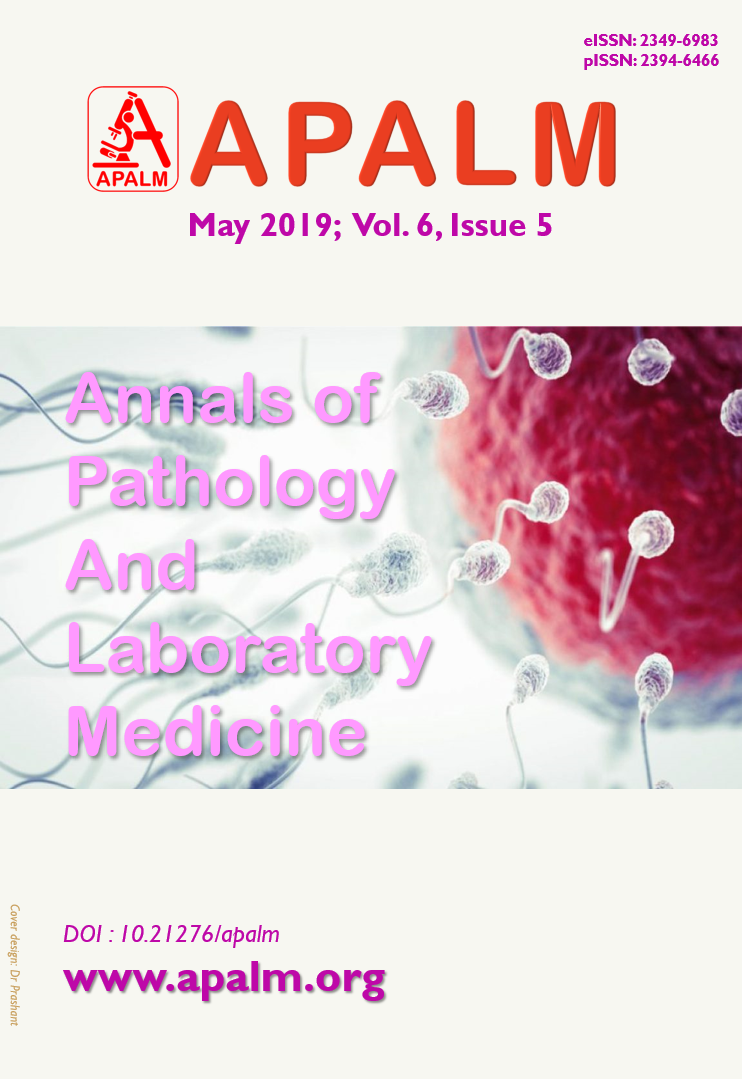Diagnostic Utility of Cell Population Data (CPD) In Sepsis Using Automated Hematology Analysers
DOI:
https://doi.org/10.21276/apalm.2395Keywords:
Sepsis, CPD, automated hematology analyzerAbstract
Background: Sepsis still remains an important cause of morbidity and mortality posing a diagnostic challenge to clinicians across the globe. Lack of a single specific and sensitive test paved the way to many researches. Our study evaluated clinical significance of cell population data (CPD) as biomarkers in sepsis. CPD assesses morphological and functional characteristics of leucocytes using automated hematology analyzer.
Methods: The study population consisted of 100 healthy subjects and 100 clinically suspected cases of sepsis with quick sequential organ failure assessment (qSOFA) score >2. The various cell population data (CPD) were collected using automated hematology analyzer, Sysmex XN1000 during a span of 6 months from January to June 2018 in a tertiary care center and the results were statistically analyzed using Z test.
Result: The WBC count and CPD parameters were assessed. Except for neutrophil , monocyte cell size (NE-FSC, MO-Z) and lymphocyte fluorescence intensity(LY-Y) all other CPD parameters show significant difference (p<0.001) in sepsis group compared to healthy controls.
Conclusion: This study suggested utility of CPD parameters which provide details of size and internal structure of leucocytes to be considered as an important biomarker for diagnosis and management of sepsis.
References
2. Park SH, Park CJ, Lee BR, et al. Sepsis affects most routine and cell population data (CPD) obtained using the Sysmex XN-2000 blood cell analyzer: neutrophil-related CPD NE-SFL and NE-WY provide useful information for detecting sepsis. Int J Lab Hematol 2015;37:190-8
3. Le Roux G, Vlad A, Eclache V, et al. Routine diagnostic procedures of myelodysplastic syndromes: value of a structural blood cell parameter (NEUT-X) determined by the
Sysmex XE-2100. Int J Lab Hematol 2010;32:237-43
4. Urrechaga E, Boveda O, Aguirre U. Role of leucocytes cell population data in the early detection of sepsis. J clin pathol 2017; 0:1—8
5. Buoro S, Mecca T, Azzarà et al. Extended leukocyte differential count and C-reactive protein in septic patients with liver impairment: diagnostic approach to
evaluate sepsis in intensive care unit. Ann Transl Med 2015;3(17):244
6. Goyette R E, Key N S, Ely E W. Hematologic changes in sepsis and their therapeutic implications. Seminars in respiratory medicine and critical care 2004;25:646-659
7. Funke A, Berner R, Trailer B, Schmeisser D, Leitis JU, Neimeyer C M..Frequency,natural course,and outcome of neonatal neutropenia.Pediatrics 2000;106:45-51
8. Furundarena JR, Araiz M, Uranga M, et al. The utility of the Sysmex XE-2100 analyzer's NEUT-X and
NEUT-Y parameters for detecting neutrophil dysplasia in myelodysplastic syndromes. Int J Lab Hematol 2010;32:360-6
9. Urrechaga E, Boveda O,Aguirre U,Garcia S,Pulido E.Neutrophil cell population data biomarkers for acute bacterial infection..J pathol infect dis 2018;1:1-7
10. Linssen J, Aderhold S, Nierhaus A, et al. Automation and validation of a rapid method to assess the neutrophil and monocyte activation by routine fluorescence flow cytometry invitro .Cytometry B Clin cytom 2008;74:295-309.
11. Seghezzi M ,Sabrina B, Previtali G.A preliminary proposal for quality control assessment and harmonization of leuckocytes morphology —structural parameters. J med biochem 2018;37:1-13
12. Lippi G, Plebani M. Biomarker research and leading causes of death worldwide: a rather feeble relationship. Clin Chem Lab Med 2013;51:1691-3
13. Chaves F, Tierno B, Xu D. Quantitative determination of neutrophil VCS parameters
by the Coulter automated hematology analyzer: new and reliable indicators for acute
bacterial infection. Am J Clin Pathol 2005;124:1—5.
14. Vincent JL, Beumier M. Diagnostic and prognostic markers in sepsis. Expert Rev Anti
Infect Ther 2013;11:265—75.
Downloads
Published
Issue
Section
License
Copyright (c) 2019 Shalini P, Purnima S Rao, Sneha Rao A R, Manjula Anil, Athira Benny, Sandhya I

This work is licensed under a Creative Commons Attribution 4.0 International License.
Authors who publish with this journal agree to the following terms:
- Authors retain copyright and grant the journal right of first publication with the work simultaneously licensed under a Creative Commons Attribution License that allows others to share the work with an acknowledgement of the work's authorship and initial publication in this journal.
- Authors are able to enter into separate, additional contractual arrangements for the non-exclusive distribution of the journal's published version of the work (e.g., post it to an institutional repository or publish it in a book), with an acknowledgement of its initial publication in this journal.
- Authors are permitted and encouraged to post their work online (e.g., in institutional repositories or on their website) prior to and during the submission process, as it can lead to productive exchanges, as well as earlier and greater citation of published work (See The Effect of Open Access at http://opcit.eprints.org/oacitation-biblio.html).










